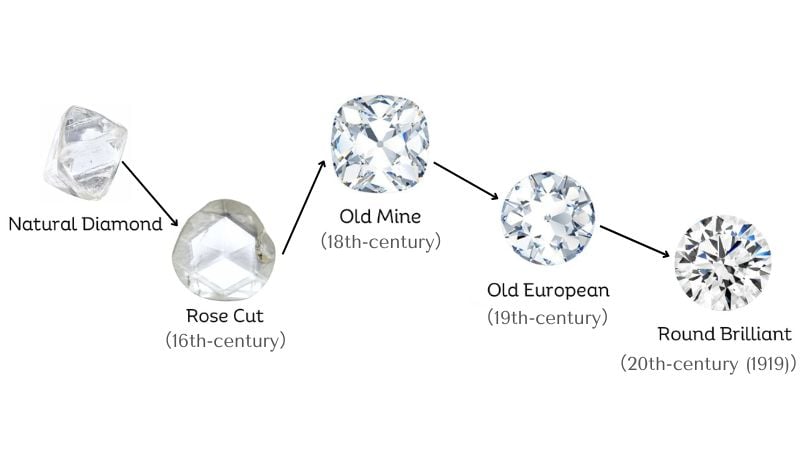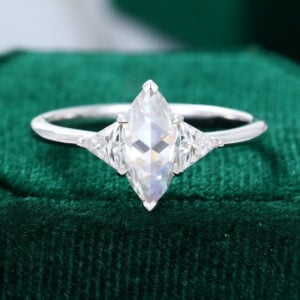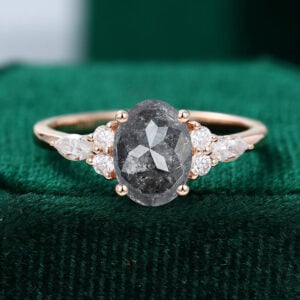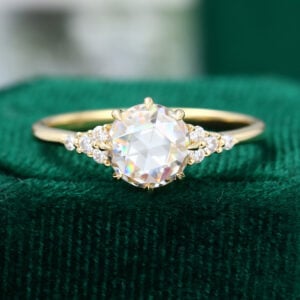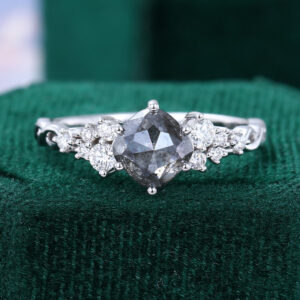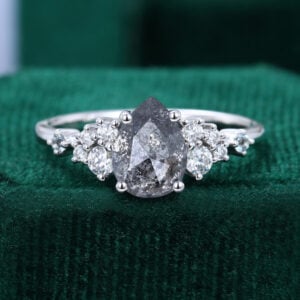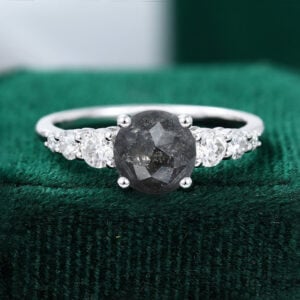The rose cut, a historic and artistic gemstone cut that, while not as common in modern cuts, holds a unique place in the jewelry world with its distinctive shape and optical effects. Ready? We will take you through the definition, characteristics, history, pros and cons, selection and care, etc. to understand the charm of this classic cut.

Table Of Contents:
- What Is a Rose Cut?
- Rose Cut Origins and Historical Evolution
- Why Did the Brilliant Cut Replace the Rose Cut?
- Pros and Cons of the Rose Cut
- How to Identify a Rose Cut?
- Rose Cut Jewelry Selecting and Caring Tips
- FAQs About Rose Cut
What Is a Rose Cut?
The rose cut is one of the oldest diamond-cutting techniques, originating in 16th-century Europe during the Renaissance. Known for its soft contours, layered triangular facets, and matte texture, it was a hallmark of royal jewelry and Victorian-era antique pieces.
Core Characteristics of the Rose Cut
- Structure
- Crown: Features a domed top with 3-24 triangular facets radiating from a central point, resembling a rosebud.
- Pavilion: Completely flat with no pavilion facets. This design allows the gemstone to fit closely to a metal base, making it ideal for flush setting.
- Shape
Rose cut can be applied to many shapes, including round, oval, pear, kite, and hexagonal designs. The most common shapes are round, oval and cushion. The rose cut can also be made into a variety of irregular shapes. - Optical Effects
With fewer facets, rose-cut diamonds scatter and diffuse light, creating a hazy, “frosted” texture. While they have less fire (color dispersion), they produce a silky, warm glow – especially striking in low light, similar to moonlight. - Cut Variants
- Single Rose Cut: Features facets only on the crown, with a flat pavilion.
- Double Rose Cut: Incorporates reverse‑cut facets on the pavilion as well, enhancing light reflection and increasing brilliance.
- Dutch Rose Cut: Denser facets, commonly seen in 17th‑century antique jewelry.
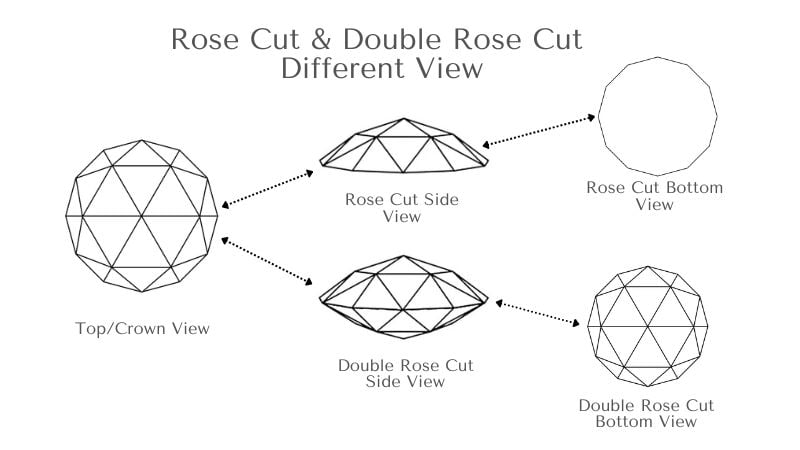
Rose Cut Origins and Historical Evolution
- Background of Origin
Emerging in 16th-century Antwerp, Netherlands, the rose cut was named for its petal-like layers. Designed to maximize candlelight reflection in pre-electricity eras, it gave diamonds a soft luminosity. - Golden Age
From the 18th to 19th centuries, the rose cut was prevalent in European courts. It was widely used in brooches, earrings, and pocket watch decorations, and was a common feature in Georgian jewelry (1714–1837). Due to the limited cutting technology of the time, rose-cut diamonds often retained the original crystal’s flat form, resulting in the distinctive “sugar loaf” profile. - Period of Fall Out of Favor
The dominance of the rose cut was gradually superseded in the late 19th and early 20th centuries with the birth of the old mine cut, the old European cut, and especially the ideal brilliant-cut (introduced in 1919). The brilliant cut, which maximizes light reflection and refraction to enhance a diamond’s brilliance, quickly became the industry standard. - Modern Revival
“Outdated ≠ forgotten.” Since the beginning of the 21st century, indie designers and luxury brands (e.g., Chanel, Dior) have reimagined the rose cut with asymmetrical designs and mixed materials, blending classic and contemporary aesthetics.
Why Did the Brilliant Cut Replace the Rose Cut?
- Adapting to the Electric Age:
The rose cut relies on diffuse natural light reflection to produce a soft, enchanting glow under the candle or oil lamp light. However, as electricity became widespread in the late 19th century, consumers began seeking diamonds that dazzled under electric lighting – a criterion perfectly met by the brilliant cut. - The Impact of Art Deco (1920s–1930s):
The Art Deco period emphasized geometric lines and mechanical aesthetics, and the sharp fire of the brilliant-cut was more in line with the quest for “modernity” of the time, while the matte texture of the rose cut was seen as “old-fashioned”. - The Quest for Ultimate Brilliance & Fire:
Rose cut typically features facets only on the crown (usually no more than 24), whereas brilliant cut (often with 58 facets) employs complex pavilion facets (e.g., star facets and lower girdle facets) to achieve total internal reflection, resulting in brilliance and fire far surpassing that of the rose cut. - De Beers’ Diamond Marketing:
In the mid-20th century, De Beers’ “A Diamond Is Forever” campaign established the brilliant cut engagement ring as a symbol of eternal love. Since then, the brilliant-cut has become the industry consensus.
Pros and Cons of the Rose Cut
Rose Cut Pros
- Retains over 65% of the raw crystal’s weight, making it cost‑effective and more environmentally friendly.
- For the same carat weight and shape, rose cut diamonds appear larger than brilliant cuts.
- Its flat pavilion allows for flatter setting designs, offering lighter and more comfortable wear.
- Given the same quality, the per-carat price is generally lower than that of the brilliant cut.
- The rose cut is forgiving and versatile regarding a gemstone’s color, allowing any hue to produce a unique effect.
Rose Cut Cons
- Fewer facets result in reduced brilliance compared to modern cuts.
- This cut is more likely to show flaws and requires a high level of clarity in the gemstone.
- With a flat pavilion directly contacting surfaces, it is prone to wear and oxidation; its thinner design also makes it less resistant to pressure, necessitating careful handling.
How to Identify a Rose Cut?
- Visual Inspection
- Pavilion: When you flip the gemstone, you should see a smooth, flat surface with no conical pavilion.
- Facet Arrangement: The crown features radiating triangular facets with a distinct central point.
- Luster: Under strong light, the diamond exhibits a soft, diffused reflection rather than sharp flashes.
- Instrumental Inspection
Use a 10x loupe to check facet symmetry and base wear (common in antique jewelry). - Certification
Antique rose cut may lack GIA reports but can be authenticated by AGL/SSEF for age.
Rose Cut Jewelry Selecting and Caring Tips
Purchasing Advice
- Style Match: Ideal for those who favor vintage, bohemian, or minimalist aesthetics.
- Proportions: Choose a diamond with a crown height-to‑diameter ratio of about 1:5 to avoid an overly flat appearance.
- Symmetry: Excellent symmetry enhances optical performance and best showcases the rose cut’s charm.
- Protective Settings: Opt for bezel or channel settings to protect the pavilion from exposure.
Care Guidelines
- Cleaning: Gently brush with a soft brush dipped in mild soapy water, and avoid ultrasonic cleaners that might cause vibrations leading to cracks in the pavilion.
- Storage: Store your jewelry separately in a velvet-lined box to prevent scratches from friction with other pieces.
- Repair: If the pavilion develops scratches, have a professional jeweler polish it. (may reduce weight slightly.)
Recommended Rose Cut Products
FAQs About Rose Cut
Are Rose Cut Diamonds Durable?
While diamonds rank 10 on the Mohs scale, rose cuts’ thin profile makes them prone to chipping. Use protective settings.
Do Rose Cut Diamonds Appear Larger than Brilliant Cut Diamonds?
Yes! With no pointed pavilion, they spread weight wider—like a shallow bowl holding 100ml vs. a tall glass.
Rose Cut More Expensive?
No. Lower demand and simpler craftsmanship make them 30–50% cheaper than brilliant cut.
Are Rose Cut Diamonds Worth It?
It depends on how you look at it. If you like a softer light effect, then rose cut definitely worth it. They make the gemstone look bigger and are also cheaper.
When Did Rose Cut Decline?
Key decline began in 1919 with the ideal brilliant cut’s invention. Back then, people were more interested in the sparkle of diamonds.
Are Rose Cut Diamonds Rare?
Modern rose cuts account for ~0.1% of diamonds, but they were mainstream in the 16th-19th centuries.
Do Rose Cut Diamonds Dull Over Time?
All diamond cuts can appear slightly dull over time, but a simple cleaning will restore their original brilliance.
Why Do People Love Rose Cut Diamonds?
People love them for their understated elegance, vintage charm, making gemstone appear larger, budget-friendly, and eco-conscious appeal – a win-win-win-win!
Rose Cut vs. Double Rose Cut: What Is the Difference?
The double rose cut features facets on the pavilion as well, which reflect and refract more light to enhance brilliance. However, for the same weight, a double rose cut may appear smaller than a single rose cut because the additional pavilion facets reduce the overall surface area.
Are Rose Cut Suitable for Engagement Rings?
Absolutely. If you favor a vintage and understated style, a rose cut engagement ring is an excellent choice. Plus, you can achieve a larger‑looking diamond on a lower budget – why not?
Rose Cut – A Symbol of Timeless Craftsmanship
In today’s jewelry world, which often chases dazzling brilliance, the rose cut reminds us that true luxury isn’t necessarily about eye‑popping sparkle; it’s about the culmination of craftsmanship and history. Whether you’re collecting a 19th‑century antique brooch or commissioning a modern engagement ring, the rose cut tells an eternal story of time and artisanal dedication.
Related Readings:
